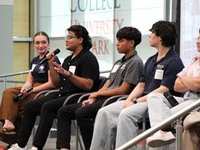- Sections :
- Crime & Public Safety
- Restaurants & Food
- Sports
- More
Categories
School’s in Session – Some handy info for non-students

THE WOODLANDS, TX – Wednesday marks the first day of the 2022-2023 school year for Conroe Independent School District (and others). Woodlands Online has compiled a quick, handy guide to help non-students and everyday commuters with the transition from summer break to schooltime blues.
School Zones
Reduced speed limits are used for school zones during the hours when children are going to and from school. Generally, the zones indicated on the signs should be in effect only during the following specified intervals:
• from approximately 45 minutes before school opens until classes begin
• from the beginning to the end of the lunch period
• for a 30-minute period beginning at the close of school
The typical school zone speed in a residential area is 20 miles per hour; however, this can alter depending on location, so don’t just assume you’ll have to go 20 every time you see the blinking yellow light. Speaking of which, not all school zones are noted by lights, so ensure you always keep an eye out for signs.
Speeding through a school zone can cost you in more ways than one. Fines start at $200 for speeding up to 5 mph over the posted limit and can easily exceed $300. Drivers caught speeding in school zones can also expect an extra $25 court cost added on to the cost of their ticket. This money is collected and used to fund school crossing guard programs and other child safety programs.
Also, cell phones are a big no-no in school zones. Texas law prohibits using a cell phone when driving through an active school crossing zone. Exemptions include vehicles that are stopped, drivers using hands free devices, or drivers making a call to emergency services (police, fire or other first responders).
Finally, and this is a little convoluted, if you’re in a school zone when its active time starts up expires, you are still subject to the laws of the zone until you exit. For example, say a school zone becomes active at 8:00 a.m. and you enter it at full speed at 7:49; if you take longer than a minute to get out, you’re speeding as soon as the clock strikes eight. Also, don’t rely on your dashboard clock giving you the correct time, and err a few minutes on the side of caution.
Crosswalks
You may have noticed some new signs in the area that have popped up next to pedestrian crossings that aren’t always situated at intersections. This is due to the Lisa Torry Smith Act that went into effect across Texas last September. Also known as Senate Bill 1055, the law states that if a driver causes bodily harm to “a pedestrian, a cyclist or a person operating a motor-assisted scooter, at a crosswalk,” they can be charged with a misdemeanor, and if the pedestrian is seriously injured, the charge could be a felony. You must come to a complete stop if you see someone at the crossing; pedestrians have the right of way. However, the law does not allow pedestrians to step from a curb and move into a crosswalk into the path of a vehicle that is “so close that it is impossible for the vehicle operator to stop and yield,” so everyone involved needs to use common sense and common courtesy.
Buses
There are too many videos out there on social media showing impatient drivers who zoom around stopped school buses (even taking to the sidewalk to do so). We at Woodlands Online have a single word in response: DON’T. You are far more likely to hit a student exiting a school bus than you are hitting one in a school crossing zone, because too often the bus itself blocks clear view between driver and pedestrian until it’s too late.
If you’re behind a school bus, each and every time it puts on its blinking red lights (usually preceded by blinking yellow), stop immediately. Don’t creep forward, don’t rev your engine, don’t try to swing around into the next lane; your stillness is best for the safety of the children. Texas law dictates that all traffic must come to a complete stop as long as the red lights are flashing (oftentimes accompanied by a swing-out stop sign). This is for any cars behind the bus, any cars facing the bus from the oncoming, opposite side of the road, or cars facing the profile of the bus from a side street. The only exclusion to this is if oncoming traffic is separated by a physical median between the opposing sides of the road. Even so, please exercise caution whenever there’s a yellow bus about. To do otherwise could net you a fine up to $1,000.
Be aware of your surroundings
It’s easy for us to have gotten into the summertime groove when driving. Backing out of our driveways or going through an apartment or business parking lot to reach the main road might be something we’ve been doing on autopilot. It’s worth realizing that the chances of a student walking across your driveway behind your car, or wandering through your apartment complex or taking a shortcut through a strip center parking lot, have gone up considerably once the school year began. It would behoove you to add extra alertness to your driving habits in these areas.
Finally, one major difference between summertime and schooltime is the traffic. Be prepared to have your drive time double or more, at least for a while. While it may be gratifying to lean on your horn or yell at everyone outside your car, we at Woodlands Online encourage you to instead find a calming audiobook or soothing playlist to listen to during your commute.
Safety. Awareness. Success.
School Zones
Reduced speed limits are used for school zones during the hours when children are going to and from school. Generally, the zones indicated on the signs should be in effect only during the following specified intervals:
• from approximately 45 minutes before school opens until classes begin
• from the beginning to the end of the lunch period
• for a 30-minute period beginning at the close of school
The typical school zone speed in a residential area is 20 miles per hour; however, this can alter depending on location, so don’t just assume you’ll have to go 20 every time you see the blinking yellow light. Speaking of which, not all school zones are noted by lights, so ensure you always keep an eye out for signs.
Speeding through a school zone can cost you in more ways than one. Fines start at $200 for speeding up to 5 mph over the posted limit and can easily exceed $300. Drivers caught speeding in school zones can also expect an extra $25 court cost added on to the cost of their ticket. This money is collected and used to fund school crossing guard programs and other child safety programs.
Also, cell phones are a big no-no in school zones. Texas law prohibits using a cell phone when driving through an active school crossing zone. Exemptions include vehicles that are stopped, drivers using hands free devices, or drivers making a call to emergency services (police, fire or other first responders).
Finally, and this is a little convoluted, if you’re in a school zone when its active time starts up expires, you are still subject to the laws of the zone until you exit. For example, say a school zone becomes active at 8:00 a.m. and you enter it at full speed at 7:49; if you take longer than a minute to get out, you’re speeding as soon as the clock strikes eight. Also, don’t rely on your dashboard clock giving you the correct time, and err a few minutes on the side of caution.
Crosswalks
You may have noticed some new signs in the area that have popped up next to pedestrian crossings that aren’t always situated at intersections. This is due to the Lisa Torry Smith Act that went into effect across Texas last September. Also known as Senate Bill 1055, the law states that if a driver causes bodily harm to “a pedestrian, a cyclist or a person operating a motor-assisted scooter, at a crosswalk,” they can be charged with a misdemeanor, and if the pedestrian is seriously injured, the charge could be a felony. You must come to a complete stop if you see someone at the crossing; pedestrians have the right of way. However, the law does not allow pedestrians to step from a curb and move into a crosswalk into the path of a vehicle that is “so close that it is impossible for the vehicle operator to stop and yield,” so everyone involved needs to use common sense and common courtesy.
Buses
There are too many videos out there on social media showing impatient drivers who zoom around stopped school buses (even taking to the sidewalk to do so). We at Woodlands Online have a single word in response: DON’T. You are far more likely to hit a student exiting a school bus than you are hitting one in a school crossing zone, because too often the bus itself blocks clear view between driver and pedestrian until it’s too late.
If you’re behind a school bus, each and every time it puts on its blinking red lights (usually preceded by blinking yellow), stop immediately. Don’t creep forward, don’t rev your engine, don’t try to swing around into the next lane; your stillness is best for the safety of the children. Texas law dictates that all traffic must come to a complete stop as long as the red lights are flashing (oftentimes accompanied by a swing-out stop sign). This is for any cars behind the bus, any cars facing the bus from the oncoming, opposite side of the road, or cars facing the profile of the bus from a side street. The only exclusion to this is if oncoming traffic is separated by a physical median between the opposing sides of the road. Even so, please exercise caution whenever there’s a yellow bus about. To do otherwise could net you a fine up to $1,000.
Be aware of your surroundings
It’s easy for us to have gotten into the summertime groove when driving. Backing out of our driveways or going through an apartment or business parking lot to reach the main road might be something we’ve been doing on autopilot. It’s worth realizing that the chances of a student walking across your driveway behind your car, or wandering through your apartment complex or taking a shortcut through a strip center parking lot, have gone up considerably once the school year began. It would behoove you to add extra alertness to your driving habits in these areas.
Finally, one major difference between summertime and schooltime is the traffic. Be prepared to have your drive time double or more, at least for a while. While it may be gratifying to lean on your horn or yell at everyone outside your car, we at Woodlands Online encourage you to instead find a calming audiobook or soothing playlist to listen to during your commute.
Comments •




















